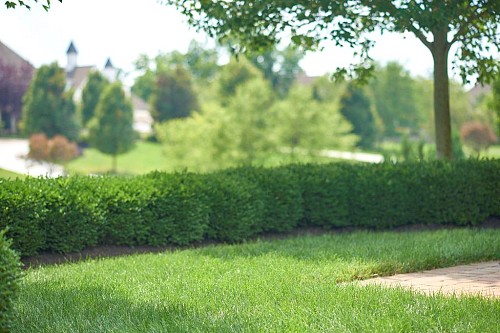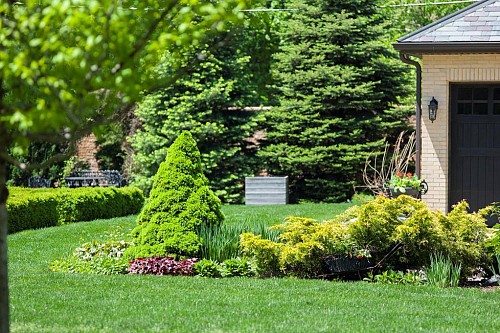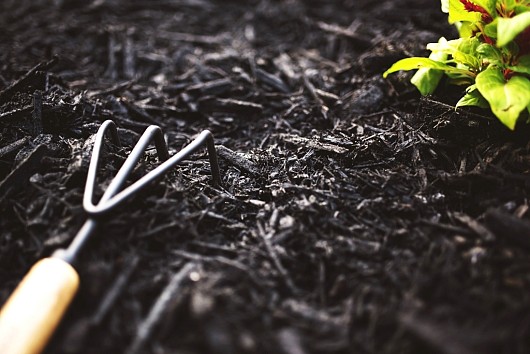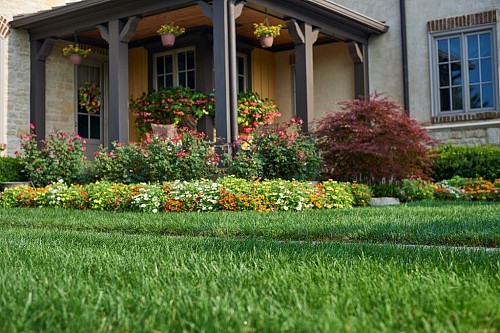Spring Clean Up For Your Lawn And Garden
 Get your lawn and garden ready for a great growing season. The essential first step, whether you DIY or hire a local landscaper: take care of basic spring clean up. We show you how, with the professional advice of Phil Dwyer, Ph.D., turf grass scientist and Amy Enfield, Ph.D., consumer horticulturist, both of Scotts Miracle-Gro.
Get your lawn and garden ready for a great growing season. The essential first step, whether you DIY or hire a local landscaper: take care of basic spring clean up. We show you how, with the professional advice of Phil Dwyer, Ph.D., turf grass scientist and Amy Enfield, Ph.D., consumer horticulturist, both of Scotts Miracle-Gro.
Spring clean up for your lawn

- Clear the lawn. Clear your lawn of twigs, stones, and garbage. Remove damaged turf, too. Then scrape away dead grass with a lawn rake. Weed-free dead grass and other organic debris can be composted.
- Repair bare spots. The best time for overseeding bare spots depends on your grass type and local climate. Seed cool-season grasses, common in the northern U.S., in early spring. Warm-season grasses in southern climates can wait until a little later in the season. After seeding, water daily till the grass reaches a good mowing height (about 2”). If the lawn’s especially thin, apply a multiuse product to improve the surrounding soil, fill bare spots with new grass seed, and feed.
- Get rid of weeds. For a lawn with only a few weeds, hand weeding will work, especially if they have shallow roots, like chickweed. However, for deeper-rooted weeds (such as dandelion or thistle), or when hand pulling is too much effort, you might need to apply a weed killer.
- Prep the mower; then mow high. Before the first mowing this season, clean and tune up your lawn mower. Once new grass has grown at least two inches, turn the mower deck to the highest setting for your grass type. Why? Tall grass grows deeper roots that absorb more moisture and block weeds.
- Feed. Feed the same time as you first mow, to help grass grow longer roots. This creates a thicker, greener lawn with improved tolerance for summer heat, drought, and foot traffic. To save time and effort, consider a multipurpose product that can feed your lawn, prevent weeds, and keep away insect pests, as well. Be sure to choose the right product for your locale.

Spring clean up for your garden
- Clear debris. Start by clearing large objects like sticks or pine cones. Then rake up fallen leaves and other small debris. The soil’s freeze-thaw cycles throughout winter and early spring sometimes push rocks to the garden surface, so be on the lookout and pick those up too.

- Prep soil to optimize growing conditions. Grab a handful of dirt and squeeze – if it crumbles, your soil has dried enough so you can start preparing garden beds. Clumping, OTOH, shows it’s still too wet to work. Once the soil is dry, remove any dead plants, prune lifeless branches, and mix in compost or readymade composted soil.
- Remove weeds. Pull weeds the right way: remove not just stems but also the entire root, so unwanted plants won’t grow back. Weeds come out easier when they’re still small and your soil is damp. If they have a deeper root system, or the root doesn’t show when you pull by hand, pry up with a spade or digging fork.
- Stop weeds before they sprout. Treat with a weed preventer in spring, creating a barrier in the soil that prevents listed weed seeds from growing. (Always follow label directions when using.)
- Mulch. Well-maintained mulch helps stop weed seed germination, retains moisture, and even adds curb appeal. Apply a 2- to 3-inch layer of fresh mulch once the soil has warmed and dried enough to pass the squeeze test (see above). Leaving some garden soil bare provides nesting space for beneficial insects like bees.
- Edge beds. Holding a flat-bladed spade or a lawn edger at a 30-degree angle, slice a clean edge where the garden beds meet the lawn. Cut deeply enough to remove any grass roots growing into the beds.
- Plant cool-weather plants. Add color to landscape beds and container gardens now by planting pansies, snapdragons, sweet alyssum, and other cool-weather-loving plants. Early spring is also a great time to start cool-season vegetables like cabbage, broccoli, spinach, kale, and snap peas. Yum!

Laura Firszt writes for networx.com.
Looking for a Pro? Call us (866) 441-6648

Landscaping Average Costs
Landscapers Experiences

“Stealth” Tree Trimming Was An Incredibly Clean Job

Fast Professional Tree Service For My Crabapple And Persimmon

Careful, Professional Tree Service Removes A Huge Norway Maple
Top Cities Covered by our Landscapers
Austin
| Boston
| Charlotte
| Chicago
| Columbus
| Dallas
| Denver
| Detroit
| El Paso
| Fort Worth
| Houston
| Indianapolis
| Jacksonville
| Los Angeles
| Nashville
| New York
| Philadelphia
| Phoenix
| Portland
| San Antonio
| San Diego
| San Francisco
| San Jose
| Seattle


